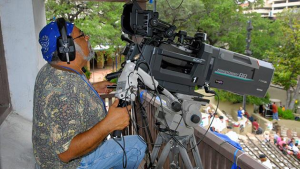High Definition Television

HDTV has been a long time coming, from the psycho-visual experiments by NHK in the 1970s, through the format wars of the 1980s and the IT/TV battles of the late 1990s. The first practical equipment appeared in 1985 this was deployed in Japan with some pioneers in Europe and the USA. The Equipment was mainly analogue but in fact already used quite a lot of Digital Processing in the cameras and recorders.
The politics also hotted up around this time and European manufacturers successfully parted the EU from many millions of ECUs (predecessor to the Euro) to develop an all European system. So now we had both rival 50Hz and 60Hz HDTV production and transmission systems. The Japanese had MUSE (multiple subnyquist sampling encoding) and the Europeans had HD MAC (Multiplexed Analogue Components) for Transmission. The European lobby made much of the fact that all the receivers would need to be changed if the Japanese system won, they omitted to say that this was also the case if the European system won.
For production equipment the pinnacle of performance was achieved in the late '80s with large format CCD camera’s and uncompressed Digital recorders.
The early '90s was a cooling off period though with some useful standardization work including the much lauded common image format which used the same 1920 x 1080 Image format for both 50 Hz and 60Hz.
The end of the '90s was dirty tricks time, influential senators remembered that the Broadcasters had successfully quarantined spectrum for HDTV Broadcasting and put pressure on them to make it so. The Broadcasters at this time were preoccupied with the threat of mult-ichannel using compression over cable and Sattelite. They then coined the phrase DTV (Digital TV) and tried to deflect the politicians. Enter also at this time software vendors who could just about process Standard definition in real time and didn't understand the broadcast interlace system. Using political influence and calling in High School Allegiances they managed to initially dilute the DTV offering to NTSC Progressive scan. The Broadcasters now seeing a threat from another direction then switched back into an HDTV agenda. The outcome of all this was the infamous ATSC (Advanced Television System Committee) table 3 with around 30 different broadcasting formats. The eventual result was a split between Broadcasters with some supporting the normally interlace Common Image Format of 1920 x 1080 for both Production and Transmission, and others supporting the 1280 x 720 progressive format much loved by the IT community. Progressive eats double the bandwidth but was easier to process by the novice software writers of the time.
With luck in Europe the target for mainstream HDTV will be both the common image format (1920 x 1080) and progressive scan. Luckily, the NTSC Progressive Format also known as 480P has passed away.
Behind this story the Professional Equipment vendors were trying hard to make Equipment Better, Lighter, Cheaper. This resulted in a significant degradation of picture quality over the costly but superior equipment of the late 1980s. In particular subsampling luminance and chrominance then compressing it to death confused the format debate by seriously degrading the capabilities of the 1080 I format. Another interesting point was the realisation that Film images in 50 Hz systems were carried as progressive images @ 25P. This concept went back to the 1960s but was invented as new and promoted heavily as the HD 24P system when the term field dominance morphed into segment dominance. Woe betide anyone who got the dominance the wrong way and tried to display motion on a Digital Projector.
So moving into the second decade of the 21st Century, many Broadcasters are on air. The 'religious' arguments around the various formats have quietened down and finally the technology is approaching the performance of the late '80s but with a healthier price tag. The prospect is that any newer system (such as UHDTV) will finally abandon interlace.
